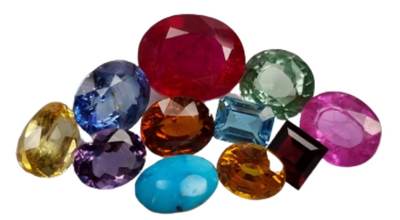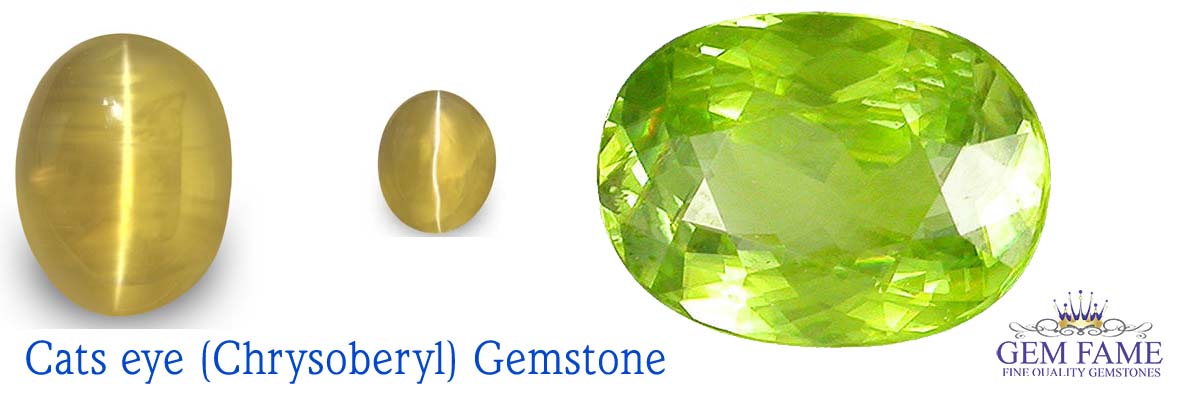Cats eye (Chrysoberyl) Gemstone
Cats eye (Chrysoberyl) is beryllium aluminium oxide BeAl2O4 and forms highly characteristic transparent to translucent pseudo-hexagonal, multiple contact and penetration twinned or prominently striated short prismatic crystals in the orthorhombic system. The hardness is 8.5 and there is a distinct cleavage in one direction. While the luster is vitreous crystals may be opaque and chatoyant with oriented inclusions.
Alexandrite is most commonly dark green with a color change to raspberry red when viewed successively in daylight or its artificial near-equivalent and incandescent lighting. Chatoyant chrysoberyl shows an eye when translucent and cut with a dome (cabochon) which allows incident light to reflect with a sharp eye from parallel included crystals or channels to the upper surface of the finished stone. Transparent chrysoberyl apart from alexandrite is often very bright and pleasing golden to greenish yellow, sometimes dark orange or brown, rarely colorless.
The RI for the alpha, beta and gamma rays is 1.746, 1.748 and 1.756 respectively, biaxial positive with birefringence 0.008–0.010. The SG is in the range 3.71–3.72. Pleochroism is strong, and in alexandrite, shows red, yellow-orange and emerald-green colors. The absorption spectrum of yellow-green or dark brown chrysoberyl is notable for the broad absorption band centered at 444 nm in the violet. In dark specimens the observer may also see bands at 505 and 485 nm and in very brown stones the general absorption of the blue and violet conceals the 444 band.
Before examining the absorption spectrum of alexandrite we should first remember to consult Anderson and Payne’s text (passim) on absorption spectra and then the stone’s strong pleochroism where the highest RI direction is green, the lowest red or purple and the intermediate ray orange.
The observer will need to note that the absorption spectrum shows some differences depending upon the direction examined. In the green ray the narrow doublet at 680.5 and 678.5 nm is particularly prominent with the 680.5 nm band the stronger. Weaker lines can be seen at 665, 655, 649 and 645 nm. The broad central absorption extends from about 640 to 555 nm and appears to show two deeper areas of concentration. Blue and violet are completely absorbed from about 470 nm.
In the red or purple ray the doublet is weaker and the 678.5 nm band is now the stronger. Two other lines, at 655 and 645 nm are seen in the red. The broad absorption is now 605–540 nm, well away from the red and accounting for the change to red with appropriate lighting. A clear line can be seen at 472 nm, sometimes accompanied by a weaker line at 468 nm. The absorption of the blue is now seen at 460 nm. Anderson and Payne (1998) carried out the investigations so far quoted on Siberian alexandrite in which the color change is stronger (more chromium) than that shown by Sri Lankan alexandrite. In Sri Lankan alexandrite the broad absorption zones are less intense than in Siberian (and the recently discovered Brazilian) alexandrite.
Between crossed filters most alexandrite will show a distinct red (more than might be expected in Sri Lankan specimens) and any such response from a Cats eye entitles it to the name alexandrite, providing there is some color change. Compared with ruby the emission doublet in the red is far less strong but can be seen with careful observation and appropriate lighting. The strong pleochroic colors red, yellow-orange and green are not associated with the color change.
While Cats eye is a characteristic mineral of granite pegmatites associated with mica schists or reaction zones in ultramafic rocks, gem crystals are found most often in placers. Brazil, long a producer of the best and brightest yellow-green chrysoberyl, has in recent years become the producer of magnificent alexandrite from the Lavra de Hematitafield in Minas Gerais.
The best material from this deposit equals or even surpasses alexandrite from the Takovaya emerald mines, north-east of Yekaterinburg [Sverdlovsk], Russia. The color change is pronounced in the best alexandrite from both sources. Alexandrite was named in 1982 for Tsar Alexander II. Crystals are most commonly found as star-shaped twins (trillings) reaching 2 cm across in some examples. The host rock is a mica schist.





